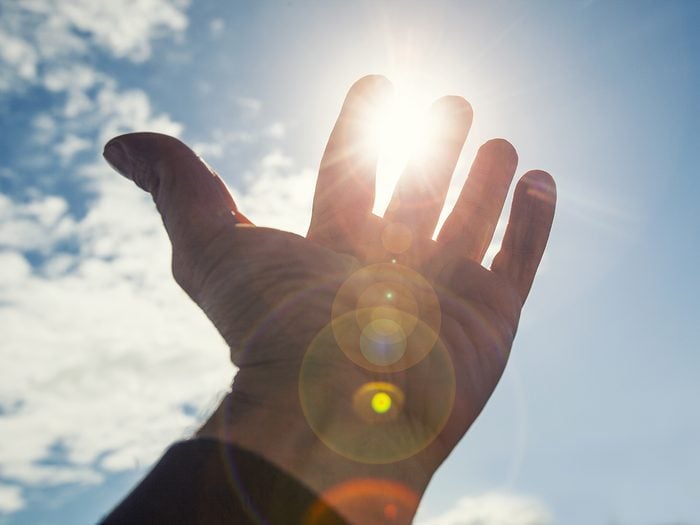
How to Tell Time, Naturally!
It wasn’t until the 20th century that our lives truly became regulated by clocks—and only a few years since the trusty smartphone replaced the clock itself in governing our daily schedule.
But what happens when you forget or misplace your watch, or a string of Tiktok videos drains your smartphone battery while you’re strolling through the woods? Luckily, nature’s given us several ways of gauging the time of day without the aid of modern technology. Learn how to tell time with five back-to-basics strategies that could help you keep your appointments—and maybe even save your life.

How to tell time using the sun
If the display on your smartphone ever fails you, there are other digits you can use to tell the time—that is to say, your fingers.
Start by planting your feet towards the sun, extending one arm fully in front of you, and rotating your wrist so your palm is facing you horizontally. Close your fingers together and align your pinky with the horizon.
Now, count how many finger widths it takes to reach the sun. Depending on the season and time of day, you may need to continue stacking one hand over the other to keep count. Four finger widths represent one hour of sunlight, so unless you have exceptionally thin (or thick!) fingers, a count of eight finger widths during a southern Ontario July would equal two hours of remaining sunlight (roughly 7:30 p.m.).
Don’t miss these natural disaster survival tips from a Red Cross volunteer.

Tell the time by tracking the sun’s position
You don’t have to have been a Girl Guide or Boy Scout to know that when the sun is sitting in the centre of the sky, it’s around noon; and that the sun rises in the east and sets in the west. Basic stuff—but usually not enough to tell the time with any degree of precision.
To get a more refined reading from the sun, you’ll need to have an idea of the number of daylight hours in your particular location, given the season. If you’re in Winnipeg, for example, a typical June day casts 16 hours of daylight. With this in mind, you can divide the sky into an imaginary arc from east to west consisting of 16 equal segments to represent the approximate time. In this particular case, sunrise would be due east at about 5:30 a.m. and sunset would be due west towards 9:30 p.m.
Here’s what everyone gets wrong about daylight saving time.

Follow your shadow
Your shadow is the last thing to be afraid of when wandering in a remote wilderness.
As you’ve likely noticed, your body casts a different shadow as the day progresses. The position of the sun in the sky overhead causes our shadows to be shortest around noon, and longest in the early morning and late evening. What’s more, they move—and if you can manage to find north, you can use your own body as a makeshift sundial, reading the direction and length of your shadow to get a rough estimate of the time of day.
(Psst—if you’re not sure how to find true north without a compass, take this crash-course in orienteering!)
Find out why meteorologists get forecasts wrong—and more fascinating facts about weather prediction.

Look to the stars
This time-telling trick is virtually exclusive to Canadians, as it’s dependent on the observer’s proximity to the North Pole—and a clear night sky. According to Earthsky.org, the Big Dipper and Polaris (the trusty North Star) are circumpolar, meaning they’re always above the horizon in our night sky. As it turns out, it’s possible to use these distant pinpricks of light as an astronomical clock, with Polaris at its centre.
To locate the North Star, trace an imaginary line extending from the two outermost stars in the bowl of the Big Dipper. This line acts as the “hour hand” of the star clock, which makes a full rotation over the span of 24 hours in a counter-clockwise motion. Depending on the month of the year, you can use this formula to get a rough estimate of the late-night hour.
Discover the best places for stargazing across Canada.

Use your body clock to tell the time
Ever wake up five minutes before your alarm was set to go off? That irritating habit is down to your internal body clock, or in scientific jargon, your circadian rhythms. The National Institute of General Medical Sciences defines these 24-hour rhythms as naturally-produced processes within the body that are affected by environmental factors, such as daylight. This means telling the time can be as simple as going with your gut—literally.
Think about it: Do you tend to use the bathroom around the same time every day? If you’ve never noticed a pattern, try keeping track for a week while making note of any consistencies. Speaking of regularity, you may also notice a sudden boost of energy during a certain hour each day. This “biological clock” might help you approximate the time of day based on your natural physiological processes.
Now that you now how to tell time anywhere, check out our roundup of travel hacks that could save your next vacation.